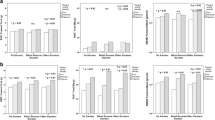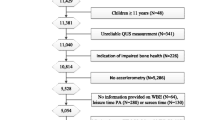Abstract
This study aimed to evaluate the association between objectively measured habitual physical activity and calcaneal and forearm bone mineral density (BMD, g/cm2), one mechanically more loaded and one less loaded skeletal region, in children aged 6–8 years. BMD was measured in 297 boys and 265 girls by peripheral dual-energy X-ray absorptiometry in the forearm and calcaneus. An accelerometer registered the level of physical activity during 4 days (2 weekdays and the weekend). Weight, height, and skinfold thickness were measured. In order to establish thresholds (count · min−1) for bone-stimulating physical activity, we evaluated different definitions of vigorous physical activity. The boys had 3.2% higher distal forearm bone mineral content (BMC, P < 0.001) and 4.5% higher distal forearm BMD (P < 0.001) than the girls. They also carried out 9.7% more daily physical activity and spent 14.6–19.0% more time in vigorous physical activity (all P < 0.05) compared to the girls. In contrast, the girls had 3.8% higher calcaneal BMC (P < 0.01) and 2.5% higher calcaneal BMD (P < 0.05) than the boys. Both calcaneal and forearm BMD were significantly related to total time of daily physical activity as well as with intense physical activity above all the chosen cut-off points (all P < 0.05). The β value for mean count · min−1 physical activity was significantly lower than that for all the chosen cut-off points of vigorous activity both for calcaneal and distal forearm BMD. This study suggests that both habitual daily physical activity and amount of vigorous physical activity in children aged 6–8 years are associated with appendicular BMD.

Similar content being viewed by others
References
Davies JH, Evans BAJ, Gregory JW (2005) Bone mass acquisition in healthy children. Arch Dis Child 90:373–378
Kelly PJ, Morrison NA, Sambrook PN, Nguyen TV, Eisman JA (1995) Genetic influences on bone turnover, bone density and fracture. Eur J Endocrinol 133:265–271
Specker BL (2001) The significance of high bone density in children. J Pediatr 139:473–475
Kannus P, Haapasalo H, Sankelo M, Sievanen H, Pasanen M, Heinonen A, Oja P, Vuori I (1995) Effect of starting age of physical activity on bone mass in the dominant arm of tennis and squash players. Ann Intern Med 123:27–31
Bass S, Pearce G, Bradney M, Hendrich E, Delmas PD, Harding A, Seeman E (1998) Exercise before puberty may confer residual benefits in bone density in adulthood: studies in active prepubertal and retired female gymnasts. J Bone Miner Res 13:500–507
Karlsson MK, Johnell O, Obrant KJ (1995) Is bone mineral density advantage maintained long-term in previous weight lifters? Calcif Tissue Int 57:325–328
Scerpella TA, Davenport M, Morganti CM, Kanaley JA, Johnson LM (2003) Dose related association of impact activity and bone mineral density in pre-pubertal girls. Calcif Tissue Int 72:24–31
MacKelvie KJ, Khan KM, Petit MA, Janssen PA, McKay HA (2003) A school-based exercise intervention elicits substantial bone health benefits: a 2-year randomized controlled trial in girls. Pediatrics 112:e447–e452
Gutin B, Kasper MJ (1992) Can vigorous exercise play a role in osteoporosis prevention? A review. Osteopor Int 2:55–69
Forwood MR, Burr DB (1993) Physical activity and bone mass: exercise infutility? Bone Miner 21:89–112
Nordström P, Pettersson U, Lorentzon R (1998) Type of physical activity, muscle strength, and pubertal stage as determinants of bone mineral density and bone area in adolescent boys. J Bone Miner Res 13:1141–1148
Haapasalo H, Kannus P, Sievnen H, Heinonen A, Oja P, Vuori I (1994) Long-term unilateral loading and bone mineral density and content in female squash players. Calcif Tissue Int 54:249–255
MacKelvie KJ, Khan KM, McKay HA (2002) Is there a critical period for bone response to weight-bearing exercise in children and adolescents? A systematic review. Br J Sports Med 36:250–257
Khan K, McKay HA, Haapasalo H, Bennell KL, Forwood MR, Kannus P, Wark JD (2000) Does childhood and adolescence provide a unique opportunity for exercise to strengthen the skeleton? J Sci Med Sport 3:150–164
Karlsson MK (2004) Physical activity, skeletal health and fractures in a long term perspective. J Musculoskelet Neuronal Interact 4:12–21
Morris FL, Naughton GA, Gibbs JL, Carlson JS, Wark JD (1997) Prospective ten-month exercise intervention in premenarcheal girls: positive effects on bone and lean mass. J Bone Miner Res 12:1453–1462
McKay HA, Petit MA, Schultz RW, Prior JC, Barr SI, Khan KM (2000) Augmented trochanteric bone mineral density after modified physical education classes: a randomized school-based exercise intervention study in prepubescent and early pubescent children. J Pediatr 136:156–162
Bailey DA, McKay HA, Mirwald RL, Crocker PR, Faulkner RA (1999) A six-year longitudinal study of the relationship of physical activity to bone mineral accrual in growing children: the University of Saskatchewan Bone Mineral Accrual Study. J Bone Miner Res 14:1672–1679
Zanker CL, Gannon L, Cooke CB, Gee KL, Oldroyd B, Truscott JG (2003) Differences in bone density, body composition, physical activity, and diet between child gymnasts and untrained children 7–8 years of age. J Bone Miner Res 18:1043–1050
Dyson K, Blimkie CJ, Davison KS, Webber CE, Adachi JD (1997) Gymnastic training and bone density in pre-adolescent females. Med Sci Sports Exerc 29:443–450
Bradney M, Pearce G, Naughton G, Sullivan C, Bass S, Beck T, Carlson J, Seeman E (1998) Moderate exercise during growth in prepubertal boys: changes in bone mass, size, volumetric density, and bone strength: a controlled prospective study. J Bone Miner Res 13:1814–1821
Janz KF, Burns TL, Torner JC, Levy SM, Paulos R, Willing MC, Warren JJ (2001) Physical activity and bone measures in young children: the Iowa Bone Development Study. Pediatrics 107:1387–1393
Janz KF, Burns TL, Levy SM, Torner JC, Willing MC, Beck TJ, Gilmore JM, Marshall TA (2004) Everyday activity predicts bone geometry in children: the Iowa Bone Development Study. Med Sci Sports Exerc 36:1124–1131
Fairweather SC, Reilly JJ, Grant S, Whitaker A, Paton JY (1999) Using the Computer Science and Applications (CSA) activity monitor in preschool children. Pediatr Exerc Sci 11:413–420
Trost SG, Ward DS, Moorehead SM, Watson PD, Riner W, Burke JR (1998) Validity of the Computer Science and Applications (CSA) activity monitor in children. Med Sci Sports Exerc 30:629–633
Puyau MR, Adolph AL, Vohra FA, Butte NF (2002) Validation and calibration of physical activity monitors in children. Obes Res 10:150–157
Ekelund U, Sjostrom M, Yngve A, Poortvliet E, Nilsson A, Froberg K, Wedderkopp N, Westerterp K (2001) Physical activity assessed by activity monitor and doubly labeled water in children. Med Sci Sports Exerc 33:275–281
Puyau MR, Adolph AL, Vohra FA, Zakeri I, Butte NF (2004) Prediction of activity energy expenditure using accelerometers in children. Med Sci Sports Exerc 36:1625–1631
Treuth MS, Schmitz K, Catellier DJ, McMurray RG, Murray DM, Almeida MJ, Going S, Norman JE, Pate R (2004) Defining accelerometer thresholds for activity intensities in adolescent girls. Med Sci Sports Exerc 36:1259–1266
Lunar GE, (2006) PIXI Bone Densitometer Operator’s Manual, software version 1.4 CEMDD. GE Lunar, Madison, WI 31.
De Lorenzo A, Bertini I, Candeloro N, Iacopino L, Andreoli A, Van Loan MD (1998) Comparison of different techniques to measure body composition in moderately active adolescents. Br J Sports Med 32:215–219
Altmann DG (1991) Practical Statistics for Medical Research. Chapman & Hall, London
Åstrand P-O, Rodahl K, Dahl HA, Strømme SB (2003) Body dimensions and muscular exercise. In: Åstrand P-O, Rodhal K, Dahl HA, Strømme SB (eds), Textbook of Work Physiology. Physiological Bases of Exercise, 4th ed. Human Kinetics, Champaign, IL, pp 299–313
Janz K (2002) Physical activity and bone development during childhood and adolescence. Implications for the prevention of osteoporosis. Minerva Pediatr 54:93–104
Lanyon LE, Rubin CT (1984) Static vs. dynamic loads as an influence on bone remodelling. J Biomech 17:897–905
Turner RT, Riggs BL, Spelsberg TC (1994) Skeletal effects of estrogen. Endocr Rev 15:275–300
Bass SL, Saxon L, Daly RM, Turner CH, Robling AG, Seeman E, Stuckey S (2002) The effect of mechanical loading on the size and shape of bone in pre-, peri-, and postpubertal girls: a study in tennis players. J Bone Miner Res 17:2274–2280
Sundberg M, Gardsell P, Johnell O, Karlsson MK, Ornstein E, Sandstedt B, Sernbo I (2002) Physical activity increases bone size in prepubertal boys and bone mass in prepubertal girls: a combined cross-sectional and 3-year longitudinal study. Calcif Tissue Int 71:406–415
Ridgers ND, Stratton G, Fairclough SJ (2005) Assessing physical activity during recess using accelerometry. Prev Med 41:102–107
Riddoch CJ, Bo AL, Wedderkopp N, Harro M, Klasson-Heggebo L, Sardinha LB, Cooper AR, Ekelund U (2004) Physical activity levels and patterns of 9- and 15-yr-old European children. Med Sci Sports Exerc 36:86–92
Trost SG, Pate RR, Sallis JF, Freedson PS, Taylor WC, Dowda M, Sirard J (2002) Age and gender differences in objectively measured physical activity in youth. Med Sci Sports Exerc 34:350–355
Rasmussen S, Petersen TA, Madsen M (2002) Body height of 6-15-year-old school children measured in the period 1986/1987 to 1996/1997 compared with Danish measurements in 1971/1972 [in Danish]. Ugeskr Laeger 164:5011–5015
Petersen TA, Rasmussen S, Madsen M (2002) BMI of Danish school children measured during the periods 1986/1987–1996/1997 compared to Danish measurement in 1971/1972 [in Danish]. Ugeskr Laeger 164:5006–5010
Fewtrell MS (2003) Bone densitometry in children assessed by dual X-ray absorptiometry: uses and pitfalls. Arch Dis Child 88:795–798
Schoenau E, Saggese G, Peter F, Baroncelli GI, Shaw NJ, Crabtree NJ, Zadik Z, Neu CM, Noordam C, Radetti G, Hochberg Z (2004) From bone biology to bone analysis. Horm Res 61:257–269
Khan K, McKay HA, Kannus P, Bailey DA, Wark JD, Bennell KL (2001) Physical Activity and Bone Health. Human Kinetics, Champaign, IL
Carter DR, Bouxsein ML, Marcus R (1992) New approaches for interpreting projected bone densitometry data. J Bone Miner Res 7:137–145
Sundberg M, Gardsell P, Johnell O, Ornstein E, Sernbo I (1998) Comparison of quantitative ultrasound measurements in calcaneus with DXA and SXA at other skeletal sites: a population-based study on 280 children aged 11–16 years. Osteoporos Int 8:410–417
Zebaze RM, Welsh F, Juliano_Burns S, Evans A, Seeman E (2004) The femoral neck is ellipsoid: the assumption of circularity of parallelepipedal shape introduces errors in volume and volumetric bone mineral density. J Bone Miner Res 19(suppl 1):S366
Author information
Authors and Affiliations
Corresponding author
Rights and permissions
About this article
Cite this article
Hasselstrøm, H., Karlsson, K.M., Hansen, S.E. et al. Peripheral Bone Mineral Density and Different Intensities of Physical Activity in Children 6–8 Years Old: The Copenhagen School Child Intervention Study. Calcif Tissue Int 80, 31–38 (2007). https://doi.org/10.1007/s00223-006-0137-9
Received:
Accepted:
Published:
Issue Date:
DOI: https://doi.org/10.1007/s00223-006-0137-9




